Jamie Todd Rubin's Blog, page 7
January 31, 2025
Remembering Barry N. Malzberg
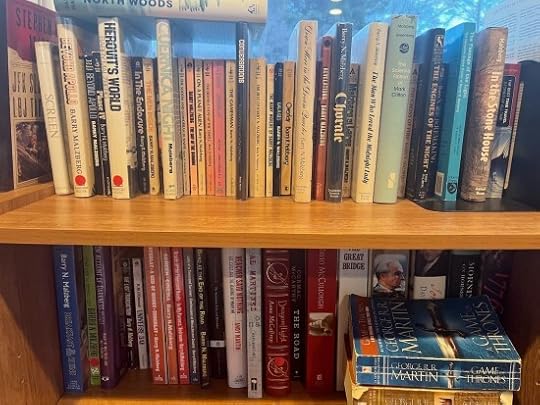 I. The Passage of the Light
I. The Passage of the LightBarry N. Malzberg died on December 19, 2024. I got an email from my friend Michael A. Burstein on December 20th alerting me to his passing. Of the many writers I got to know over the years, Barry was the closest thing to a mentor that I had. Each time I’d get an email from him or see him in the halls at Readercon, I had this surrealistic feeling: here was this great and talented artist who had taken an interest in me and my work. As I said to him once, it was as if I had befriended Derek Jeter and we were out in the yard having a catch. He knew what I meant.
After receiving the news of his passing, I sat glumly in my office for more than an hour, not moving, not writing, just thinking. I wanted to write something about him and what his writing and mentoring meant to me. Usually, this kind of thing came easily to me, but this time it did not. I was genuinely sad. It has taken some time, but here at last are some thoughts and memories I have that I think are worth sharing.
II. Malzberg’s WorldThough he may not know it, I have Scott Edelman to thank for first introducing me to Barry Malzberg. One afternoon between my junior and senior years at the University of California, Riverside, I was browsing the magazine rack at a bookstore in Moreno Valley, California, when I saw a copy of the July 1993 issue of SCIENCE FICTION AGE, the glossy science fiction magazine that Scott edited from 1992–2000. I wasn’t a very broad reader of science fiction at the time, and indeed, most of what I’d read since junior high school were Piers Anthony novels. It just so happened that the cover of the July 1993 issue of SF AGE had Piers Anthony’s name on it and included a story by Anthony called “A Picture of Jesus.” I never had much spare money in college, but the magazine hooked me, and somehow, I scraped up the dough for a subscription. Two issues later, in the November 1993 issue, I encountered Barry Malzberg for the first time.
The little s.f. I’d read outside of Anthony, up to that point, was not what I would call remarkable writing, although the stories themselves were often remarkable. For me, that’s what s.f. was about—the stories and the sense of wonder. That changed when I read Barry Malzberg’s story “The Passage of the Light” in the November ’93 SF AGE. The story was a work of art. Never before had I read prose as relentless and brilliant as Malzberg’s. I didn’t know that kind of writing was possible in a work of fiction. The words assaulted my emotions and senses. Even visually, looking at a two-page spread of the story, the massive blocks of unbroken paragraphs of text were astonishing. What was even more remarkable was that the story was about a writer of science fiction. It was what Scott Edelman referred to in his editorial as “recursive” science fiction:
Perhaps the most frequent practitioner of recursive SF is Barry N. Malzberg, who has written numerous novels and short stories about SF writers, such as Herovit’s World and Gather in the Hall of Planets, the latter of which was set at a science fiction convention. His short story in this issue, “The Passage of the Light,” is a sequel to perhaps the most famous of recursive short stories, “Corridors.”
I read “The Passage of the Light” in my apartment, even taking it with me to the restroom because I couldn’t put it down. I’d never read anything like it anywhere. It wasn’t just the idea of recursion. This guy could write like no one I’d ever experienced before in my life. I had been submitting stories to magazines at this point for about a year, but I could see that even with a hundred years of practice, my writing would never match the force and language that Barry Malzberg’s had.
I was fortunate to be in school where I was. UC Riverside was and is home to the Eaton Collection of Science Fiction & Fantasy. Shortly after reading “The Passage of the Light,” I found a copy of Herovit’s World and was again astounded by the writing. This was writing that was so good, one almost had to take it in small doses. It was clear that Barry had a unique style, and he brought that style to bear powerfully in his writing.
Through the second half of the ’90s, I decided that small doses weren’t enough for me anymore, and I began to tear through Barry Malzberg’s books, peaking with seven of them in 1999. I read Chorale and re-read Herovit’s World, and then read Beyond Apollo and Galaxies. I read The Engines of the Night and discovered that Barry’s essays were as good, if not better, than his stories. I read Guernica Night and The Falling Astronauts and The Sodom and Gomorrah Business and The Destruction of the Temple. I read Overlay and Underlay, which he once told me was his personal favorite. I began to collect his pseudonymous writing that was not science fiction, like Screen. I even read some of his adventure books written under the pseudonym Mike Barry.
1999 was also the year that I sent him a letter, care of the Scott Meredith Literary Agency, telling him just how much I enjoyed his writing. In college, I’d worked up the courage to send Piers Anthony a letter, knowing that he often responded to fan mail. I didn’t expect a response from Barry, but I got one—a gracious letter that, in many ways, was nothing like the characters in his stories. It is to my deepest shame that the letter was lost in a move from L.A. to the East Coast in 2002.
III. Some Notes Toward the True and WonderfulI was always a huge fan of Isaac Asimov, but I really discovered him just after he’d passed away, so that I never had the opportunity to write to him or meet him in person. As I began to sell stories and meet more people, I had the opportunity to write to Barry again. I think we were perhaps introduced first in email by Michael A. Burstein, but I’m not 100% certain of this. Barry and I began to exchange email, and I learned that his emails were as brilliant as his stories and essays—fierce, colorful, magnificent. He had the funny habit of changing the subject line of an email on each reply so that it related to whatever he was writing about. Recalling the lost letter, I made sure to preserve the email from Barry. Over the years, he sent me almost 500 of them.
He encouraged my writing. When I sold a story to ANALOG in 2010 (my third professional sale, but first to that magazine), he was the second person I told after Michael Burstein. He wrote:
I am thrilled for you. I’m happier by far than if it had been me. Give me all details, please. At your leisure.
Re-reading that email just now brought tears to my eyes. I sent Barry the story and the details of the acceptance. He wrote:
Young fella, this is as good as it gets… I want you to enjoy this to its fullest extent as long as you can. Blessings. Is a really fine piece of work. I don’t want you to touch it, let the fix go… but remember for the next time. And keep in mind Lincoln’s aphorism about the length of a man’s legs, “They should be long enough to touch the ground.” A story should be long enough to tell the story. No longer. But no shorter.
This was typical of him when reading my stories and providing feedback. He was always encouraging, always incredibly perceptive, always with insights into my own writing that I never saw myself.
My gosh, how our correspondence wandered and blossomed over the years. I told him stories of my creative writing professors in college, one of whom (Stephen Minot) he was familiar with and about whose writing he had interesting things to say (good things, to my surprise, since I always thought Professor Minot was something of a literary snob).
He was generous with his time and his connections. I’d written an odd mystery involving horse racing, about which I knew little, but about which he was quite versed. He read and commented on the story and then offered to send it to the editor at EQMM, whom he knew and recommended it to. Alas, no sale ever came of it, but I was incredibly grateful for his generosity.
When I was writing my Vacation in the Golden Age series, I regularly consulted Barry on my posts, and we had long, wonderful exchanges on the history of science fiction and the Golden Age, particularly Galaxy magazine in the 1950s.
One amusing story: By 2012, ANALOG had shifted completely to an online submission system. Barry could not navigate the system, and he asked me if I could submit a story by him and Bill Pronzini on his behalf. This I did through the online submission system. I followed it up with a note to Stan Schmidt to let him know the backstory and that the story was not mine but Barry and Bill’s. That story ultimately appeared in the March 2013 issue of ANALOG, and I was glad I could return some of the favor Barry had shown me1.
IV. Gather in the Hall of ReaderconAfter much correspondence, Barry and I finally met in person at Readercon in 2011. It was wonderful to finally meet in person. Not only that, but I was on panels for the first time ever at a conference, and I came up with the idea for and was moderator of a panel on “The Hidden History of Science Fiction.” I’d asked if Barry would be on the panel with me, and he agreed. I was incredibly nervous. Here I was moderating a panel at Readercon with Barry Malzberg, David G. Hartwell, Eileen Gunn, Darrell Schweitzer, and Fred Lerner. (David ultimately couldn’t make the panel, but Barry encouraged audience member Michael Dirda to help out.)
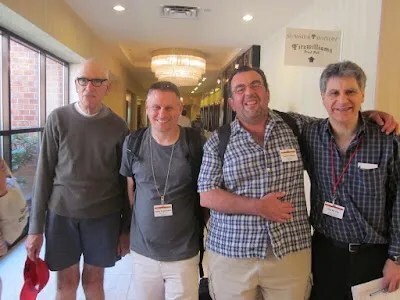
In person, I thought of Barry very much as a grandfatherly figure. I spent quite a bit of time with him, walking the parking lot—sometimes just the two of us, sometimes with others like Liz Hand and Paul Di Filippo. It was during one of these walks that I told him that walking the parking lot with him was like having a catch with Derek Jeter.
The following year I attended Readercon again and got to spend more time with Barry. I went to dinner at a nearby diner with Barry and his wife Joyce. It was just the three of us, and it was wonderful. We had tuna melts, which I gathered was a favorite of Barry’s. During those times with him, I was stunned by his memory. I’d heard of an eidetic memory before, but I’d never met anyone who seemed to actually have one. Barry did. It was incredible.
V. Beyond ReaderconWe continued to correspond after the 2012 Readercon, but I don’t think we ever saw one another in person again. Scrolling through his emails, however, I see we had long correspondences. I would tell him about my kids growing up, and he would tell me about new books coming out. In some of our last emails (ca. 2022), he was excited about reissues of some of his books by Stark House, for which he had written new introductions. He thought he’d finally mastered the art of the personal essay in those intros.
But life gets busy, and after 2022, I was remiss in emailing Barry. I thought of him frequently and would occasionally scribble a note to myself to check in with him and see how he was doing. It never happened, and I regret that.
That said, I told Barry many times over the years how much I valued his writing and friendship and how much of an impact it had on me. He was always humble, gracious, and a little self-deprecating. It was a pleasure to know him, and a pleasure to scroll through the hundreds of emails and be reminded of his remarkable writing and his remarkable mind.
Did you enjoy this post?
If so, consider subscribing to the blog using the form below or clicking on the button below to follow the blog. And consider telling a friend about it. Already a reader or subscriber to the blog? Thanks for reading!
January 24, 2025
My Tolkien Reading Plan
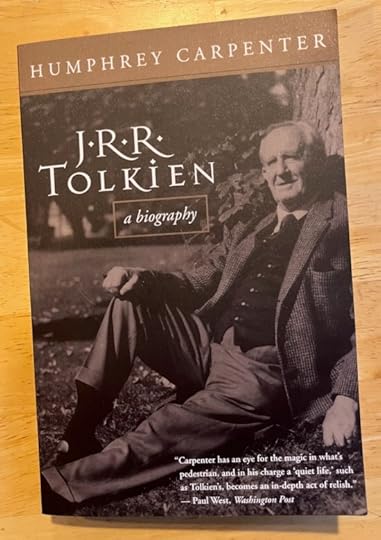
With the Tolkien diversion I mentioned yesterday, I decided that I needed a plan to execute it. I outlined my rather simplistic goals to ChatGPT (o1) and then asked for it to consider my goals and produce a reading list in the order that provides maximum entertainment, while also considering my desire to deep dive into the lore and the literary archaeology thereof. What follows is a slightly altered reading list that I intend to follow. The linked editions are the editions that I own. There are, of course, plenty of less expensive editions available.
Letters of J.R.R. Tolkien by Humphrey Carpenter J.R.R. Tolkien: A Biography by Humphrey Carpenter The Hobbit by J.R.R. Tolkien The Lord of the Rings by J.R.R. Tolkien The Silmarillion by J.R.R. Tolkien and Christopher Tolkien Unfinished Tales by J.R.R. Tolkien and Christopher Tolkien The Children of Húrin by J.R.R. Tolkien and Christopher Tolkien Beren and Lúthien by J.R.R. Tolkien and Christopher Tolkien The Fall of Gondolin by J.R.R. Tolkien and Christopher Tolkien The Complete History of Middle-Earth (12 books in 3 volumes) by Christopher TolkienI have not set any dates for completing this. I’ve learned over the years that with something like this, I have to go with the flow. It took me 24 years to complete Will Durant’s Story of Civilization, and I was perfectly fine with that. Not that it will necessarily take me as long to complete the Tolkien books, but I am a sucker for that butterfly, and so the journey will almost certainly be interrupted here and there.
I haven’t decided yet how to count some of these books on my reading list. The Lord of the Rings has often been published as three volumes (Fellowship, Two Towers, Return of the King), and the History of Middle-Earth was originally published as 12 volumes. I could, therefore, count a total of 23 books over the span of time—or as few as 12. I’m leaning toward the former because (a) my list, my rules; and (b) it makes it easier to divert for other things along the way.
Did you enjoy this post?
If so, consider subscribing to the blog using the form below or clicking on the button below to follow the blog. And consider telling a friend about it. Already a reader or subscriber to the blog? Thanks for reading!
January 23, 2025
A Tolkien Diversion
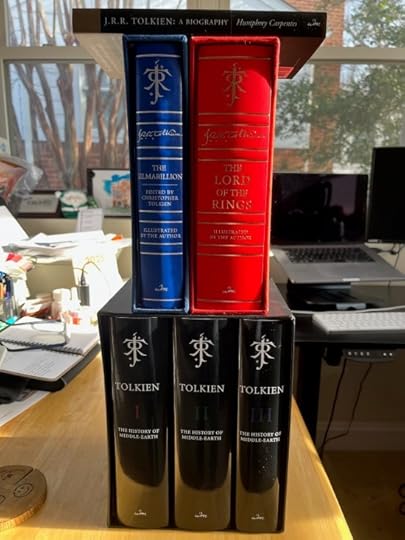
The butterfly flaps its wings and I find myself down an unexpected path. I mentioned the other day that I was going to read David Herbert Donald’s biography of Lincoln. On the way to Lincoln, however, I bumped into The Collected Letters of J.R.R. Tolkien: Revised and Expanded Edition. I read the foreword, and then the introduction, and then a few letters, and before I knew it, I was hooked. Lincoln would have to wait.
With all that’s going on right now, Tolkien might be the perfect escape. His letters have vastly increased my interest in his work. I’ve read The Hobbit and The Fellowship of the Ring, but I never completed the entire LOTR. I think that is about to change. Over time, I’ve accumulated quite a few Tolkien books and related books. I’ve got the illustrated, leather-bound edition of LOTR. I’ve got the companion edition of The Silmarillion. I have a special 3-volume edition of Christopher Tolkien’s 12 books of The History of Middle-Earth. And I’ve got J.R.R. Tolkien: A Biography by Humphrey Carpenter.
I think that when I finish the Letters, I’m going to tackle the entire Tolkien oeuvre, probably beginning with The Silmarillion, then LOTR, and on from there. His letters are a fascinating and insightful look into the construction of the story, its meaning, interpretations, and its surprises. I’ve been having so much fun reading them. I believe they’ve helped me maintain some semblance of sanity this week.
Isaac Asimov loved these books. In the second volume of his autobiography, In Joy Still Felt, he wrote of The Hobbit and LOTR, “[They] had taken me by storm, too. Since it came out, I have read it, and The Hobbit, four times and liked the books better each time1.”
As always, I’ll keep you posted on progress and may write about this exploration along the way. Also, I’m happy to hear from other people on these books, particularly the histories around LOTR itself.
Did you enjoy this post?
If so, consider subscribing to the blog using the form below or clicking on the button below to follow the blog. And consider telling a friend about it. Already a reader or subscriber to the blog? Thanks for reading!
January 22, 2025
Shelf Life
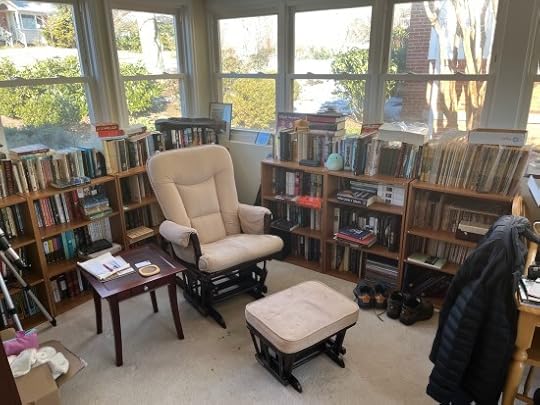
Writing is a soothing balm for me. It soothes me. Like the Star of Elendil, it provides me with a light in dark places. I’ve been wanting to write more, and my favorite writing is the writing I do here. I especially like writing about books. Last year, I tried an (unsuccessful1) experiment to write about books on Substack. Undeterred, I’ve decided to try my hand at a new series, conveniently right here. I’m calling this series “Shelf Life.”
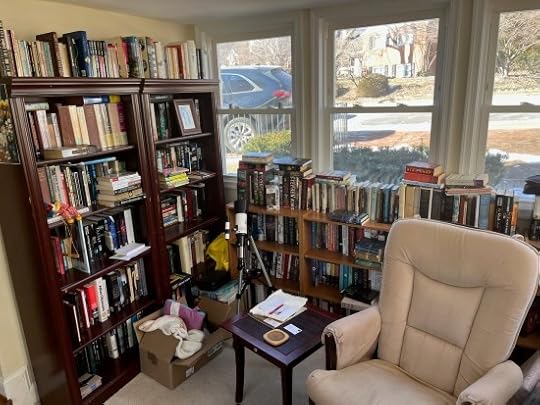
Sitting in my office one day, surrounded by my books, it occurred to me that the books themselves have stories—personal stories as they relate to me. I’m going to tell these stories. Understand that I’m not necessarily talking about the contents of the featured book, although I’m not necessarily excluding it either. I want to write about the books: how I came to obtain them, how they have impacted me, why I chose to read them or not read them, why I attempted them and failed.
I’ve started to compile a list of 52 books to start, with the idea that I’ll write about one book a week. To be honest, I don’t know if this will pan out or not. But it gives me something to look forward to, and it gives me something to focus on, to write about, and maybe it’s something that folks will be interested in reading.
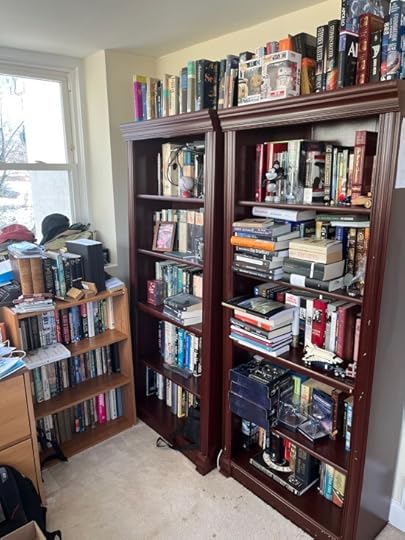
I know what book I am going to start with, and that should give you (and me) an idea of what I am trying to do. I’m looking to start this in the next couple of weeks, so stay tuned.
Did you enjoy this post?
If so, consider subscribing to the blog using the form below or clicking on the button below to follow the blog. And consider telling a friend about it. Already a reader or subscriber to the blog? Thanks for reading!
January 20, 2025
Lincoln
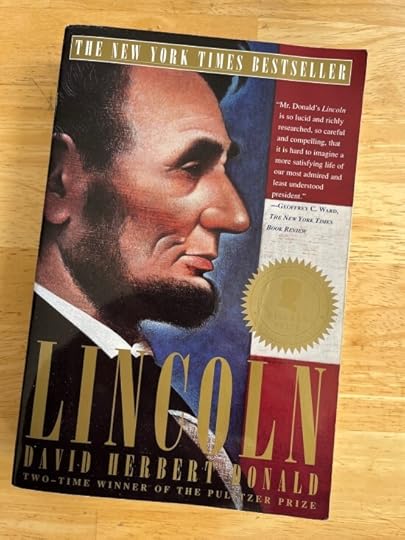
Over the years, I’ve managed to read several biographies of Abraham Lincoln. I read Carl Sandburg’s Abraham Lincoln: The Prairie Years and the War Years. I read Jon Meacham’s And There Was Light: Abraham Lincoln and the American Struggle. I read Doris Kearns Goodwin’s Team of Rivals: The Political Genius of Abraham Lincoln. One Lincoln book, however, has sat on my shelf since the 1990s without my ever having read it: David Herbert Donald’s Lincoln. I remember seeing an interview with President Bill Clinton sometime in the 1990s where he mentioned he was reading this book and recommended it, and like many other people, I went out and bought a copy, and then, never got around to reading it.
That notorious streak ends today. I’m nearly finished with this month’s book club book, and should have it finished in another hour or two. Once that is done, the Lincoln biography is next on the queue and I can correct a oversight that has gone on far too long.
Did you enjoy this post?
If so, consider subscribing to the blog using the form below or clicking on the button below to follow the blog. And consider telling a friend about it. Already a reader or subscriber to the blog? Thanks for reading!
January 14, 2025
Old Reliables: The Enduring Legacy of Century-Long Magazines
Photo by Pixabay on Pexels.com
" data-medium-file="https://i0.wp.com/jamierubin.net/wp-c..." data-large-file="https://i0.wp.com/jamierubin.net/wp-c..." src="https://i0.wp.com/jamierubin.net/wp-c..." alt="assorted book lot" class="wp-image-25787" srcset="https://i0.wp.com/jamierubin.net/wp-c... 1880w, https://i0.wp.com/jamierubin.net/wp-c... 400w, https://i0.wp.com/jamierubin.net/wp-c... 550w, https://i0.wp.com/jamierubin.net/wp-c... 768w, https://i0.wp.com/jamierubin.net/wp-c... 1536w, https://i0.wp.com/jamierubin.net/wp-c... 1200w, https://i0.wp.com/jamierubin.net/wp-c... 1800w" sizes="(max-width: 900px) 100vw, 900px" />Photo by Pixabay on Pexels.comAside from finding out that your favorite magazine is ceasing publishing–something I experienced when the wonderful SCIENCE FICTION AGE ended its 8-year run nearly a quarter century ago–one of the more depressing trends for a magazine reader is to find your magazine putting out fewer issues in the space of a year than it once did. Declining subscriptions and magazine readership has been a trend for decades now. I remember first becoming aware of this when reading the Summations in Gardner Dozois’s Year’s Best Science Fiction annual anthologies.
Perhaps that’s what drove me toward a stable of magazines that have stood the test of time. I didn’t want to be disappointed by a magazine’s sudden demise. I’m a subscriber to SCIENTIFIC AMERICAN, THE NEW YORKER, HARPER’S and THE ATLANTIC MONTHLY, all of which boast (or are about to boast) at least century-long runs. THE NEW YORKER was first published in February 1925, making next month its 100th anniversary. SCIENTIFIC AMERICAN has been around since 1845, 179 years as of this writing. HARPER’S has been around since 1850, or 174 years. And THE ATLANTIC has been around since 1857, or 167 years.
The February 2025 issue of THE ATLANTIC arrived in the mail today and after reading through “The Commons” on various takes on David Brooks’ article “How The Ivy League Broke America,” my eye caught on a box at the bottom right of the page titled “A NOTE FROM THE EDITOR IN CHIEF.” My heart sank. I’d been through this before and I knew the drill. Here we go, I thought, and I girded myself and read on.
The note began, “More than two decades ago, The Atlantic decided to reduce the number of print issues published each year, dropping from 12 to 10 and thus ending the run of what had been previously called The Atlantic Monthly.” The internet was, in part, to blame. But the next two sentences surprised and delighted me:
But the history of our magazine is filled with improbabilities, and today, more people subscribe to our print magazine than at any time since its birth, in 1857. Which is why we’ve decided to restore The Atlantic to monthly print publication beginning with the issue you are currently reading.
How about that? The editor goes on to tell us that The Atlantic crossed the million-subscription threshold in 2024. I was delighted to read this.
There is a certain feeling of bonding with the past–of continuity–that I get when reading these magazines. E. B. White’s “One Man’s Meat” column appeared in HARPER’S. Countless writers I admire, not the least of which being John McPhee, have written for THE NEW YORKER. Mark Twain wrote pieces for THE ATLANTIC MONTHLY. And I’m always delighted reading the “50, 100 & 150 Years” section of SCIENTIFIC AMERICAN to see what the magazine was publishing at those milestones. Part of it is their connection to history, and part of it is that in reading these magazines, I feel a part of the history that is unfolding today. As the Note from the Editor in Chief says, “The broader trends in the magazine business, and across journalism generally, are not promising.” But in these days of substacks and newsletters that come and go, there is something comforting about these old reliables.
Did you enjoy this post?
If so, consider subscribing to the blog using the form below or clicking on the button below to follow the blog. And consider telling a friend about it. Already a reader or subscriber to the blog? Thanks for reading!
January 13, 2025
The John McPhee Exception

I read one thing at a time. That is to say that I read many things through a given day, contemporaneously but not simultaneously. Typically, I am listening to an audiobook (Reagan: His Life and Legend by Max Boot as I write this); and have a paper book on the nightstand (Franklin Delano Roosevelt: Champion of Freedom by Conrad Black). And I read a lot of magazine articles. Generally speaking, my rule for magazine articles is that I read them in the actual paper magazine. Ostensibly, this gives my eyes some time during the day when they are not fixed on a screen. The feeling is akin to floating in warm, calm water.
There are two exceptions, the main one being when a magazine (or a stand-in for a magazine) is only available online. I try to squeeze these in to times otherwise filled with boredom. Standing in lines, waiting for meetings to start, doctor’s office waiting rooms, for instance.
Then there is the John McPhee exception. I enjoy my paper magazine time, but spoiled as I have been by our world of instant gratification, I will read a John McPhee piece on a screen as soon as I am aware of its existence. For instance: I subscribe to the New Yorker and every time I get the magazine in the mail, I scan its table of contents hoping for another installment of John McPhee’s ongoing series of “Tabula Rasa” pieces. The New Yorker is published on Mondays and usually ends up in my mailbox on Wednesday or Thursday. Sometimes–today for instance–I can’t help myself and I’ll open the app on my phone to scan the table of contents.
Today, in scanning the TOC, there it was: “Tabula Rasa: Volume Five” by John McPhee.
I could tell you that I hesitated, that I thought to myself, imagine how nice it will be to read this on paper in a few days’ time. But I flunked the marshmallow test, gang. I forgot about everything else I was doing and sank into the bliss of John McPhee’s writing. No writer of creative nonfiction since E. B. White has given me such enjoyment.
Did you enjoy this post?
If so, consider subscribing to the blog using the form below or clicking on the button below to follow the blog. And consider telling a friend about it. Already a reader or subscriber to the blog? Thanks for reading!
January 10, 2025
Sanderson, Stormlight, and Presidential Parallels
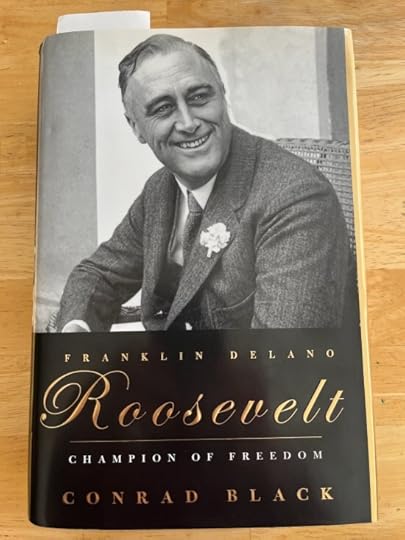
While on vacation in Florida for the holidays, I finished reading Brandon Sanderson’s Wind and Truth, book 5 in the Stormlight Archive series and the end of the first “arc” of the series. It was a fun read and a worthy conclusion to the “arc.” It was also a long read—over 1,300 pages—so it took me longer than usual to finish it. I am amazed at Sanderson’s ability to write action and emotion and weave a complex tale that is both original and avoids clichés and tropes. It is why I continue to read the series. I’ve been hesitant to read other Sanderson books, although I hear good things about them. I’m sure I’d like them, but I mostly read nonfiction these days, and when I turn to fiction, it has to be really high caliber and reliably entertaining to make it worthwhile for me. Fortunately, the Stormlight Archive books fit those criteria.
I finished the book just a few days ago, on January 8, so it is the first book I’ve completed in 2025. Had I finished it in 2024, it probably would have made #9 on my best reads of the year. The story runs the gamut of emotions, and I especially appreciate the humor scattered throughout. I also appreciated a line from the 6th interlude about books and their relationship with culture and civilization:
Books, a weight of information gathered meticulously by his ancestors, each a work of art. This was humankind at its best, standing against the tide of darkness with ink and pen.
Sanderson writes an end-of-year assessment of his work, the state of Sanderson. In this year’s assessment, he noted that, given the various writing projects he’s got going, he doesn’t expect book 6 of the Stormlight Archive to appear until 2031, nearly seven years hence. Having given up waiting for George R. R. Martin’s 6th volume of his magnum opus and having waited patiently for the 3rd volume of Patrick Rothfuss’s series, seven years doesn’t really seem too bad. One thing Sanderson has going for him that Martin and Rothfuss don’t seem to have is consistency and reliability in their scheduling. Sanderson’s output seems remarkable, but he also seems highly regimented in his work and planning. So when he says seven years, I feel like I can count on this as a reliable estimate.
Meanwhile, having gotten my fill of fiction (and with another piece of fiction coming up soon for my book club), I’ve returned to nonfiction but have stayed with the recent trend of reading long books. I’m currently engaged in a little experiment. I am simultaneously reading Franklin Delano Roosevelt: Champion of Freedom by Conrad Black, a nearly 1,300-page biography of the 32nd President. At the same time, I am listening to the audiobook version of Reagan: His Life and Legend by Max Boot.
The Roosevelt book is the 6th biography of FDR that I have read, but for some reason, I never get tired of reading about him. I find the different approaches to FDR interesting, and they help paint a more balanced picture than any one book alone. FDR was a hero of Reagan’s, and when I saw the Max Boot biography, I thought it might be interesting to read their lives in parallel. So far, I’m enjoying it. The Reagan biography is only the 2nd Reagan biography I’ve read, the first being H. W. Brands’ Reagan: The Life. I tried reading Edmund Morris’s official biography of Reagan, Dutch, but was turned off by its semi-fictional style. That was disappointing because I’ve twice read Morris’s 3-volume biography of Theodore Roosevelt, as well as a marvelous collection of his essays, The Living Hand.
Max Boot, by the way, attended the same high school and humanities program that I attended in Reseda, California. We overlapped for a single year, 1987, although I am not aware we ever interacted during that time. There have been other Max Boot books I’ve wanted to read, for instance, The Road Not Taken: Edward Lansdale and the American Tragedy in Vietnam. From what I’ve read of the Reagan biography so far, I’ll look forward to reading others.
Did you enjoy this post?
If so, consider subscribing to the blog using the form below or clicking on the button below to follow the blog. And consider telling a friend about it. Already a reader or subscriber to the blog? Thanks for reading!
January 9, 2025
My Best Reads of 2024
Photo by Element5 Digital on Pexels.com
" data-medium-file="https://i0.wp.com/jamierubin.net/wp-c..." data-large-file="https://i0.wp.com/jamierubin.net/wp-c..." src="https://i0.wp.com/jamierubin.net/wp-c..." alt="assorted books on book shelves" class="wp-image-25760" srcset="https://i0.wp.com/jamierubin.net/wp-c... 1880w, https://i0.wp.com/jamierubin.net/wp-c... 400w, https://i0.wp.com/jamierubin.net/wp-c... 550w, https://i0.wp.com/jamierubin.net/wp-c... 768w, https://i0.wp.com/jamierubin.net/wp-c... 1536w, https://i0.wp.com/jamierubin.net/wp-c... 1200w, https://i0.wp.com/jamierubin.net/wp-c... 1800w" sizes="(max-width: 900px) 100vw, 900px" />Photo by Element5 Digital on Pexels.comWith 2024 behind us, I can finally post my list of best reads for 2024. Each year, I have a goal of reading 100 books. I didn’t make my goal in 2024, reading 85 books, but that is because many of them were very long. So rather than including the 10 best reads, I am going to include 8 to keep to the top 10 percent of books that I read in 2024. I was going to wait until morning to post this, but I’m already 9 days late, so here they are:
The World She Edited: Katharine S. White at the New Yorker by Amy ReadingE.B. White’s essays are among my favorite writing. So it was great to get a different view of his life through the eyes of his wife’s biography. Katharine S. White was a founding editor at the New Yorker, and so this biography of White was not only a biography of an extraordinary editor but also a biography of the magazine during her long tenure there. It was a fascinating read from start to finish.
The Notebook: A History of Thinking on Paper by Roland AllenI knew as soon as I saw the title of this book that I was going to like it. Sometimes, you just know. An entire book on the history of notebooks? How can someone who enjoys notebooks so much not appreciate this? And what a great history it was, covering notebooks from their origin through today, even covering the current bullet journaling trend. This was a well-written and engaging read, especially considering it is a fairly obscure subject.
The Invention of Nature: Alexander von Humboldt’s New World by Andrea WulfI probably first encountered Alexander von Humboldt in the writing of Stephen Jay Gould. Wulf’s biography of him was fantastic. I am fascinated by polymaths and hard workers, and von Humboldt was both of these. Von Humboldt was also a remarkable hub in a network of remarkable people. As I wrote in a note while reading this book:
Alexander von Humboldt turns out to be an amazing hub of science and culture. He knew Simón Bolívar and Thomas Jefferson. He made Napoleon nervous. He was admired by great scientists of Europe (Humphry Davy among others). Charles Darwin credited him with inspiring his journey on the Beagle.
After reading this biography, I bought a collection of von Humboldt’s writing and am looking forward to reading it, perhaps later this year.
Remembrance: The Selected Correspondence of Ray Bradbury edited by Jonathan R. EllerReading Ray Bradbury’s letters over the course of his lifetime was a pleasure. I was particularly delighted by some of his correspondents early on, like Leigh Brackett and Edmund Hamilton. I lived in Los Angeles for a long time and never particularly liked it, but this book made me reminiscent of a Los Angeles that no longer exists, the Los Angeles of the 1930s. It was also nice to see that Bradbury expressed the same insecurities that many up-and-coming writers express about their own writing—and found ways to overcome those insecurities.
An Unfinished Love Story: A Personal History of the 1960s by Doris Kearns GoodwinI’ve been a fan of Goodwin’s books ever since I read The Bully Pulpit: Theodore Roosevelt, William Howard Taft, and the Golden Age of Journalism in 2015. Since then, I’ve read just about everything she’s written. So to read a new Doris Kearns Goodwin book was a delight, especially one as personal as this one. I knew very little about Richard Goodwin before reading this book, but I came to admire his abilities as a political speechwriter. Early in the book, there is a reference to just how young our country really is. Goodwin, 80 at the time, says that America is just three Goodwins old. Three 80-year lifetimes is not very long.
Given the turbulent times we are living through, two passages from Richard Goodwin’s writing really stood out for me. The first was on dissent and patriotism, which is absolutely true today:
Some have called upon us to mute or stifle dissent in the name of patriotism and the national interest. It is an argument which monstrously misconceives the nature and process, and the greatest strength of American democracy. It is not our privilege, but our duty as patriots to write, to speak, to organize, to oppose any president and any party and any policy at any time which we believe threatens the grandeur of this nation and the well-being of its people. This is such a time.
On a citizen’s obligation to speak out, Goodwin wrote:
The government of the United States is not a private club or college fraternity. Its policies are not private oaths or company secrets. Presumably, a man enters public life to serve the nation. The oath taken by every high officer of the nation, elected or appointed, is to support and defend the Constitution of the United States, not an administration, a political party, or a man. Dissenters are sometimes accused of demeaning the presidency. That office should demand respect. Its dignity, however, flows not from private right or title, or the man who occupies it, but solely from the fact that its occupant is chosen by the people of the United States. It is their office, and if they, or any among them, feel it is wrongly used, then it is their obligation to speak.
The book was bittersweet, knowing the ending, but it was still a wonderful read.
You Like It Darker: Stories by Stephen KingI love that Stephen King still writes short fiction. Not many successful novelists seem to take the time to publish short fiction. This was a fun collection with at least two standout stories. “Two Talented Bastid” is the best piece of short fiction I’ve read by King since his story “A Death,” which appeared in The New Yorker in 2015. In addition to this story, there was “Danny Coughlin’s Bad Dream,” which I simply could. not. put. down.
North Woods by Daniel MasonThis was my pick for the book club I belong to, and I really liked this one. It was a unique mix of styles that let a writer really test out their range. The story was engaging and a lot of fun. This book was everything a good novel should be.
John Quincy Adams: A Man for the Whole People by Randall WoodsThis is the third biography of John Quincy Adams that I’ve read. I never tire of reading about him. He has supplanted his father as my personal favorite U.S. President. (Not necessarily the best president, just my favorite.) Given all of the biographies I’ve read of U.S. Presidents, I’d say he was probably the smartest President we’ve ever had in terms of brainpower. He was probably also the best-prepared for a job that one cannot really prepare for: Minister to the Netherlands, Minister to Prussia, Minister to Russia, Minister to the United Kingdom, member of the Massachusetts Senate, U.S. State Senator from Massachusetts, Secretary of State, President of the United States. And then, after serving a single term, he went on to serve 17 years in the U.S. House of Representatives. I read a book like this and am just flabbergasted by what Adams accomplished. My meager deeds pale in comparison.
So there’s my list for 2024. Did you have books you really enjoyed in 2024? Let me know about them in the comments.
Here are some best reads from previous years:
My best reads of 2023My best reads of 2022My best reads of 2021My best reads of 2020My best reads of 2019My best reads of 2018Did you enjoy this post?
If so, consider subscribing to the blog using the form below or clicking on the button below to follow the blog. And consider telling a friend about it. Already a reader or subscriber to the blog? Thanks for reading!
December 21, 2024
My Personal Archive System
Photo by Element5 Digital on Pexels.com
" data-medium-file="https://i0.wp.com/jamierubin.net/wp-c..." data-large-file="https://i0.wp.com/jamierubin.net/wp-c..." src="https://i0.wp.com/jamierubin.net/wp-c..." alt="gray steel file cabinet" class="wp-image-25694" srcset="https://i0.wp.com/jamierubin.net/wp-c... 1880w, https://i0.wp.com/jamierubin.net/wp-c... 400w, https://i0.wp.com/jamierubin.net/wp-c... 550w, https://i0.wp.com/jamierubin.net/wp-c... 768w, https://i0.wp.com/jamierubin.net/wp-c... 1536w, https://i0.wp.com/jamierubin.net/wp-c... 1200w, https://i0.wp.com/jamierubin.net/wp-c... 1800w" sizes="(max-width: 900px) 100vw, 900px" />Photo by Element5 Digital on Pexels.comFor years, I’ve wanted a personal archive system that allows me to easily search all of my documents, email, and other information in a useful way. Over the last few months, I’ve finally built the first iteration of what I am calling my Personal Archive System, or PAS for short.
Back in September, I wrote about how I archived all of my blog posts in Obsidian. That was an experiment to test the viability of such an archive. It provided me with plenty of files (more than 7,000) to test out different search engines. The files are all text files, which makes things like full-text search much easier. Being text files was important because, around that time, I began doing all of my work in plain text (not even Markdown) with few exceptions. Working in plain text makes the archiving process that much easier.
Why a Personal Archive?I began using a computer when I was around 11 years old, and I’ve been using them for practical things like writing papers and sending email since 1990. The vast majority of my output and my communications are in digital format. It would be wonderful to access all of that from a simple interface. Moreover, I had some other important requirements:
I wanted a one-stop shop to search everything.I wanted the system to be entirely offline. I didn’t want to have to rely on the Internet to search my archive. I wanted it all local.I wanted it to be easy for my family to use.I didn’t want to depend on commercial or other tools that seems to come and go with increasing frequency these days.While there are tool and systems and combinations thereof that might be able to do this, none of them do it the way I want it done. I want a clean simple interface that makes everything easy. So with these requirements in hand I set out writing the system, mostly in Python, using Flask as my front end framework and Whoosh as my search engine on the back end. I use SQLite databases for important indexes and other data storage. I finished the initial functionality a few weeks ago and have been using my system daily to ensure it works well for me. So far, so good.
Core Features of the SystemCurrently, there are four core features of the system:
Searching the archive. This includes searching everything in the archive, whether it is blog posts, notes, email, or information about books and reading in my book database.Viewing almanac data for any given date. In the initial release, almanac data includes:Agenda (calendar items) for the dayWhat I was reading (or started or finished reading) on a given dayWork products I created or worked on during the dayEmail I sent or received on that dayBrowser history of all of the sites I visited on the dayCommand line history for any command I issued during the dayTo-dos. The system manages my to-dos based on a simple text file I track them in.Managing my books and reading. This in itself is an entire subsystem that tracks the books in my collection as well as my reading of those books, articles, stories, and notes related to them.Here, for instance, is the home page of my personal archive system:

Personal Archive System home page
The home page simply lists the agenda for the day as well as open to-dos. But I can use the PAS to see an “almanac” for any day. For instance, here is the almanac for yesterday::
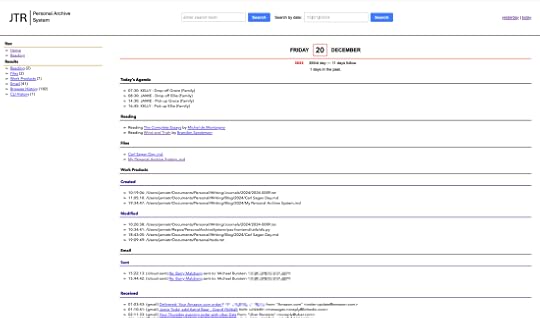
Almanac page from PAS
The left nav summarizes the almanac: I was reading two books (same ones as today). Two files were added to the archive. I worked on seven files throughout the day, creating three and modifying four. I sent two emails and received 41 emails, and I browsed 182 sites and ran one command at the command line. If I scroll through the list I can see the times at which I did these things, or drill into the details of any one of them without ever having to be online.
Here is a snippet further down the almanac for yesterday that shows some of the sites I visited and commands (or in this case, command) I issued.
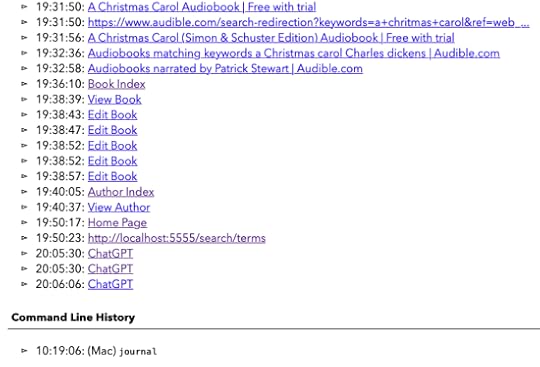
Some of the browser history and command line history.
Since the site runs on my home network, it is accessible to the family as well, and they can use this for searching or to find out when something happened. It might seem silly to have so much detail, but I can’t tell you how many times I have visited a site and then forgotten what the site was and spent a long time trying to figure it out. Or, run a series of commands to install some software and then needed to recreate that again on another system.
The Reading SubsystemHere is the homepage to the book/reading subsystem:

PAS Reading Home
My reading list knows my reading goals for the year and shows me my progress toward the goal. With just 10 days left in the year, I’m not going to make my goal, alas. The reading home page lists the books that I am currently reading and provides one-click actions to “finish” or “quit” the book. Note that it also provides an estimated completion date for each book. These estimates are based on nearly 30 years of reading list data and reading behavior and it turns out these estimates are is pretty accurate in the field.
Note that the dates in the list are hyperlinked? Clicking on a date takes me to the almanac entry for that date. Convenient!
There is a lot that I can do with this. For instance, I can click on a book to see its details. Here are the details for Wind and Truth by Brandon Sanderson:
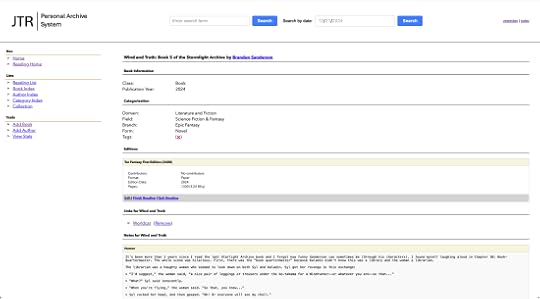
PAS Record for a Book
It has basic information about the book and then lists editions of the book that I have. When I read a book, the edition that I am reading gets added to the reading list, and that is why the edition here shows a “Finished Reading” and “Quit Reading” link — it knows I am currently reading this edition.
Below, you can see part of a note I’ve added for the book. I can add any number of notes. And the nice thing is that all of this is searchable as part of a global search of my archive.
I can also look at my complete reading list. By default, I see the current year:
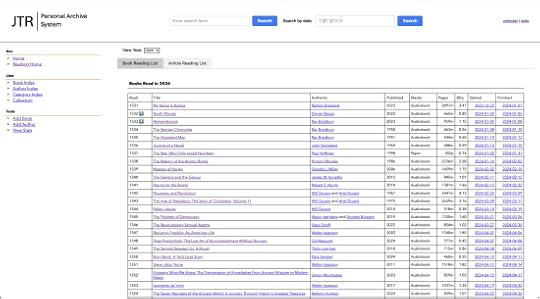
Reading list for 2024
On some of the books in the list, you’ll see a blue number like the “7” for North Woods or the “4” for Remembrance. These books are ones that I have ranked as part of my best reads of the year (the rankings may change before the end of the year).
In addition, as part of this system, I’ve started tracking the articles and other short works that I read. There is a separate tab for those. Clicking on that tab, I see:

Articles I’ve read
Just like with books, I can add notes and links to the articles, too. I can easily search through all of my books to find something specific, like this:
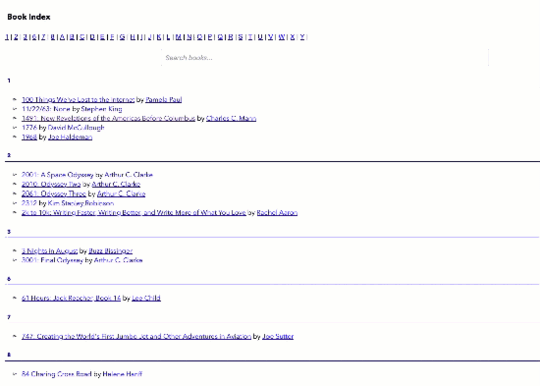
Searching titles
And I can do the same for authors. And I can add new books or articles, edit existing books, etc. There’s more that my book system can do, but you get the idea.
How the PAS System WorksFor those curious about how the system works, there are four key components:
Archivers. These are scripts that archive a particular type of information. Currently, I have two archivers: one for text files and one for email. The text file archiver searches a set of folders on my file system for different types of text files (.txt, .md, etc.) and copies them into an archive folder. It registers the file in a SQLite database. I use a hash of the file to see if the file has changed or the path has changed. When a file changes, the archiver updates the archive with the latest version of the file. The email archiver works by logging into my email accounts and checking for any new mail that it doesn’t already know about. It downloads the message, stores the message as a text file in the archive, registers the message in a SQLite database, and also stores any attachments associated with the message.Indexers. There is one indexer for each type of data. The indexers go through the data in the archive and index it using Whoosh so that it is full-text searchable.Almanac Agents. There is an agent for each kind of data I collect in the almanac. So there is an agent for pulling calendar information, gathering information about work products, pulling browser and command line histories, etc. Data from these agents is stored in SQLite databases.API. There is an underlying API (via Flask) that allows me to access the data through the front end.Each morning at about 4 a.m., the archivers run, gathering any new files or email. Once the archivers have completed their task, the indexers run to add the new data to the search indexes. Almanac agents typically run hourly, although the work product agent runs every 15 minutes.
Together, these allow me to search everything in my archive. In one of my first really helpful tests, I wanted to know if I’d ever written anything about Cleve Cartmill. So, I went to my archive and searched for “Cleve Cartmill.” The result quickly came back with nine files and three email messages. The results are returned as follows, and the sidebar lets me filter by date:
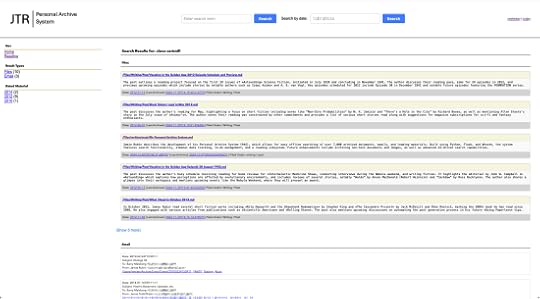
Search results
Since then, I’ve used the system for all kinds of searches. Indeed, according to the data the system collects, I’ve run 685 searches (some of them, of course, were tests). In addition, the almanac lets me go back in time. For instance, here is the almanac for January 7, 2007:
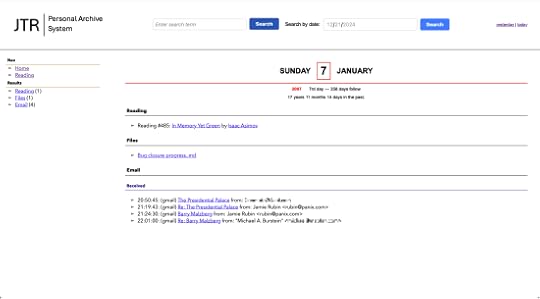
The almanac shows me how long ago the entry was–in this case 17 years, 11 months, and 14 days in the past. On that day, I was reading Isaac Asimov’s In Memory Yet Green. I published a blog post called “Bug Closure Progress” and I received 4 pieces of email.
Currently, my PAS contains:
99,836 email messages going back to 2004 (that’s 20 years worth of email)6,676 attachments associated with the email7,027 text and markdown files46,674 browser history events4,766 calendar events6,338 command line events11,209 work product events (for 10,323 work products)1,219 books and articles574 authorsCurrent DevelopmentWith an initial version working well, I’ve started on three new features: archiving “documents” and archiving curated images. Documents are things that aren’t text files, like Word or Excel files. There is a more involved process for archiving these, but it allows me to set up what I call “contexts,” which makes searching for things much easier.
I’m also working on archiving curated images. For these, I’ve experimented by sending the image to an LLM and asking for a description of everything it sees in the image, along with some search terms that someone might use to locate the image. I store this text in a SQLite database and relate it to the image in question so that when I run a search of the archive, that text is searchable and the image is returned in the search results.
But the thing I have been focusing most on is my journals. A few months ago, I ran an experiment that demonstrated that an LLM could read and transcribe both my print and cursive handwriting with a very high degree of accuracy. I’ve got a sample of 160 pages of journal entries that are now searchable as part of the archive. Moreover, they don’t just return the text but also the image of the page the text appears on.
Future DevelopmentThere are three big features I’m looking at adding in the future, once I have accumulated enough data in the archive. The first is to create embeddings for all of the files and emails using AI and storing the embeddings in a vector database to allow me to run cosine distance searches against the data. That should greatly improve the search results and take a step toward more natural language searches.
The second is to make use of semantic searches to allow for more natural language searching while returning relevant results.
Both of these are months in the future at this point. For now, I’m just happy to have a working system that I use more and more each day.
Finally, I am working on a way to associate artifacts (files, documents, email, photos) with people so that I can, for instance, select my older daughter’s name from a list and see everything I have in my archive related to her, and then filter down from there.
This is what has been keeping me so busy, but now that the core components are up and running, I am once again free to do a little more writing here on the blog. I thought you might want to know what I’ve been doing in the meantime.
Questions?I suspect this post might generate a number of questions. I’ve tried to anticipate some of them here, but if you have others, feel free to drop them in the comments and I’ll do my best to answer them:
Are you still using Obsidian?Not really. As I mentioned, I’ve switched mostly to plain text files. I used Sublime Text as my main editor for these, but the nice thing about plain text is that I can use almost any editor to edit the files. The archive itself has take the place of Obsidian. I think Obsidian is a fantastic tool, but to keep things simple, I use plain text and the archive system to manage all of my data. I do still use Obsidian as a public repository of my reading list.
Will you open source the code?I’ve made of lot of my code available in the past. While the code is in GitHub, it is currently housed in a set of private repos. While to system works well, the code behind the scenes is pretty messy. It also highly tailored to my needs. My experience with a big system like this is that if I made the code publicly available, even with the caveat that there is absolutely no support whatsoever, I’d still get a lot of email asking for help, especially getting it up and running the first time. I just don’t have the time to commit to that right now. Maybe in a later iteration, but not now. Sorry!
What about security?This runs entirely locally on my home network, which is encrypted. The archive is stored locally, backed up locally, and also backed up as encrypted backup to my cloud backup service. I feel pretty good about the level of security and don’t lose any sleep over it.
How scalable is the system?Good question. That remains to be seen. Whoosh is an older search technology, but far simpler to use than something like Lucene. I went down the Lucene path for a while and while it is more powerful and scalable than Whoosh, it didn’t seem worth the effort for a hobby project like this. So far, the searches run quickly for the most part. I don’t anticipate a huge growth on this, maybe one order of magnitude and I can revisit performance then if it warrants it.
You mentioned using AI in future features. Is the system using any AI now?There is one place where the system uses AI today. When I pull in a new text file, I use an LLM to summarize the text and the summarized text is what is presented in the search results, as opposed to the first n characters of the file. I find this to be more useful than the first few lines of a file. I use a local model via LM Studio and Llama 3.2 3B Instruct to generate the summaries, with an option to use Open AI. You can see these summaries in search results like this for the search “archiving data”:
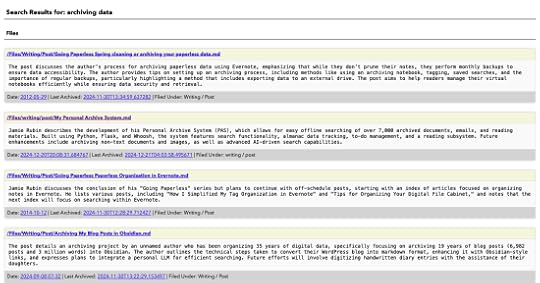
The summaries you see in the search results are generated by an LLM.
If you have other questions, drop them in the comments.
Did you enjoy this post?
If so, consider subscribing to the blog using the form below or clicking on the button below to follow the blog. And consider telling a friend about it. Already a reader or subscriber to the blog? Thanks for reading!



